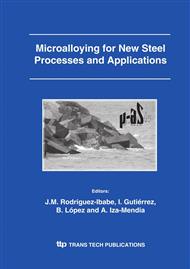p.503
p.511
p.519
p.527
p.535
p.543
p.551
p.559
p.565
Processing Low and Ultra-Low Carbon Bainitic Steels with Excellent Property Combinations
Abstract:
Six experimental low and ultra-low carbon C-Mn-Mo-Nb-B and one conventional TMCP steel heats have been prepared to study the effects of chemical composition and hot deformation on the microstructure and the strength-toughness properties. In physical simulation tests, it was found that the deformation of austenite below the non-recrystallization temperature enhances the formation of higher-temperature bainitic morphologies and polygonal ferrite. On the other hand, hardness exhibits relatively low sensitivity to the degree of deformation below Tnr, whereas the deformation results in a distinct refinement in the microstructures, as determined by SEM-EBSD measurements, suggesting an improvement in the impact toughness. Simultaneous alloying with Mo-Nb-B seemed to be most efficient to provide high hardness and strength. Hot rolling trials indicated that the yield strength in the range 500-700 MPa with the excellent toughness down to –80 °C can be achieved in low carbon (≈ 0.03%) bainitic grades.
Info:
Periodical:
Pages:
535-542
Citation:
Online since:
November 2005
Authors:
Price:
Сopyright:
© 2005 Trans Tech Publications Ltd. All Rights Reserved
Share:
Citation:


